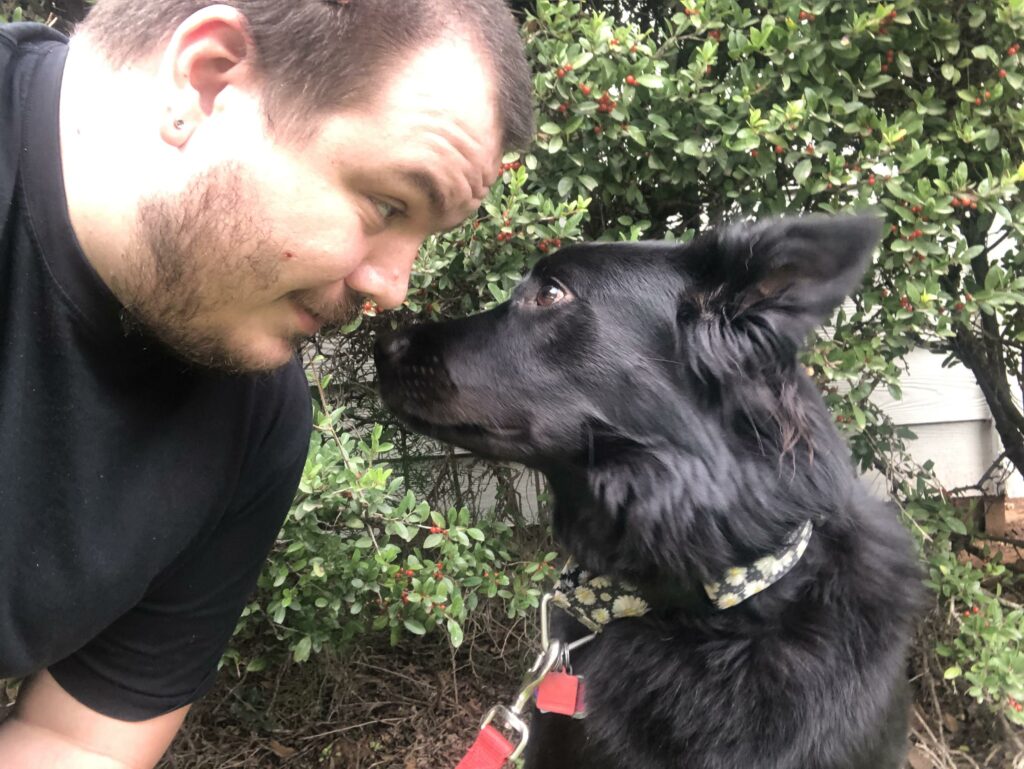Immediate Dog Training “Fixes”
The world seems very “market-y” these days. I see more and more ads proclaiming quick fixes and miraculous cures for problems in my own field, dog behavior. “Just do this and your dog’s behavior will immediately change,” many advertisements state. Some marketing experts advise me to announce that I can solve whatever problems people have with their dogs, letting them think they need only to hand over their issues. As far as they can tell, a magic wand will fix everything. Once they engage, I can reveal the truth – that they have to do some work to make the changes.
When I see the dog training ads on social media every day, I worry that dog owners may go into training thinking magic will happen. It won’t. The science of animal behavior and training can do so much when pet owners understand, and yes, believe in it. But changing the behavior of your dog takes commitment and new, specific actions that require intention and effort for dog owners to learn. (I will say that magic does appear to happen, just not overnight.)

You Have to Believe in Behavior Science at First
Believing is key in the beginning, when not much behavior change is obvious. This is the stage where having chosen your dog training coach is most important. A great teacher must be able to explain what to do and why, but it might not make much sense at first. So a great teacher must, most importantly, help you be motivated to take the actions that will lead to your success. Humans must do new things to create new ways of being. After all, “What you’ve done so far has gotten you where you are now.” You’ll have to change something if you want your circumstances to change.
Good teachers love teaching. Being a good teacher, I will answer questions about why and how behavior science works all day long. However, owners need to practice the skills they are learning, too. Part of learning to train your dog is working practice into the limited hours you have available each day. Learning new things takes both time and effort. Believing in behavior science can help bridge the gap between your starting point and the point at which you begin to understand and use new skills. A good teacher/coach is essential to help you acquire new knowledge and skills through practice that fits into your everyday interactions with your dog.
What do You Bring to the Dog Training Process?
A teacher or coach can’t do it without you, though. You will also need to dig deep within yourself. Consider whether you’re ready to change what you’re doing, question your previous beliefs about how dogs learn, and step out of your comfort zone in order to get where you want to be. Choose to be a life-long learner and reach out for new knowledge and skills. The process is difficult, or as I like to say, “challenging,” but the benefits once you climb that mountain of acquisition and come down the other side are immense.
Dog Training “Tips & Tricks”
Dog training is not about “tips and tricks,” it’s about real behavior change in both human and dog. With a good teacher, the small, achievable steps toward your goal may seem like tips and tricks, though. I love seeing student’s lives transform as they follow the curricula, sometimes reporting along the way that they are seeing a “completely different dog.” But it’s not magic, and it’s the same dog! The knowledge and skills you need are available to you because of the study of behavior science over the course of decades.
Dog Training Requires Observation Skills
Students must learn to observe. Observation skills help owners see in a new way the small bits of gold in a dog’s behavior choices, allowing development of bigger, desirable behaviors. As owners begin to develop great observation skills, the need to “believe” diminishes. They learn to actually see, on their own, behaviors developing between themselves and their dogs.
Dog Training Requires Reinforcement Skills
Positive reinforcement builds behavior. Understanding how to get a dog to perform a behavior that can be reinforced is one thing that turns a dog owner into an effective trainer. The skills to reinforce the behavior in a way that builds it rapidly is another. My mentor, Dr. Bob Bailey, often says that the most important part of animal training is “Get the behavior.” My students learn a variety of ways to get behavior. All the techniques are fun for owners and dogs, and of course humane and non-aversive. Reinforcement skills are key to teaching dogs to actually respond to cues and not just beg for treats when they see them.
Dog Training is Simple, but not Easy
Human skills make training dogs simple, if not easy. Organizational skills like keeping records, planning practice times and what to practice are key. Observing dogs to create visions for further behaviors makes future plans simple. (Thanks again, Dr. Bob, for “simple but not easy.”) The processes are simple; applying them takes effort.
“Dog Training” is an Active Verb
I just got a report from Iain, a student who has been very busy with work while planning a vacation trip for himself and his dog. He knew he needed to practice behaviors he and Daisy had learned like leash skills, recall, how she could show interest in people without barking, and more. They had learned these behaviors but allowed them to get a little rusty. Iain was procrastinating about practicing them before the trip.

I reminded Iain that the trip would be more enjoyable for both of them if he practiced the skills they needed, and that Daisy would not practice them on her own. Note: dogs don’t set up training sessions, LOL. Today, he said they had been practicing leash skills and recalls for a week and Daisy is now a champion at both! It was so exciting to see Iain get his own head in the game and practice how he had learned to get the behaviors and reinforce them. He observed, “It’s so awesome how just a little practice brings it all back! I’ve got to remember that Daisy can’t do it all by herself.” I was beaming. This dog/owner team is ready for their upcoming road trip. They have nice leash skills, a reliable recall, and a set of training tools in the form of games and exercises to help Daisy remember to show interest in new things, but do so quietly and politely. It happened because Iain remembered that he and Daisy are a team and the productive relationship they share requires his effort for maintenance.

You Create the Satisfaction
There is work to be done in order to train your dog. Immense satisfaction and fulfillment await you when you do it. Opportunities for you and your dog abound when you are a team that works together through training.
If It’s Worthwhile, It Requires Effort
My closing point is that marketing about dog trainers solving everyone’s problems in the blink of an eye is malarkey. In addition, there’s no way to evaluate whether a particular dog trainer’s program is the “best in the world.” However, the possibilities for you and your dog are endless if you choose to train and commit to learning the skills you need. Most worthwhile achievements require effort and dog training is no different. Think of learning to train your dog as a college degree in partnership. What you learn will benefit your future dogs, too.
Through learning new skills that are outside your comfort zone, behavior changes will happen and opportunities for you and your dog will explode into being. Learning something new is challenging; experiencing possibilities you never knew existed is priceless.
I’m not sure how statements like, “Take on dog training! It’s difficult and challenging!” will work as marketing blurbs. I think maybe those people who are already life-long learners probably get it. Consider your future with that wonderful dog of yours and the possibilities you want to create.


